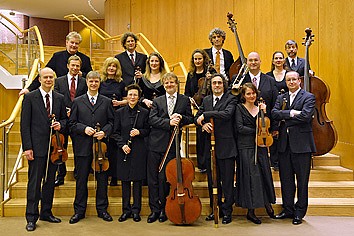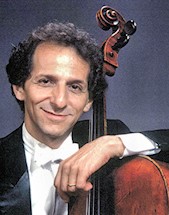
| Concerto Köln |
Reviews
The singing tone of Colin Carr’s 18th-century Gofriller cello had me from the git-go; every time he hit an authoritative low note, or even better, a series of them, my spine just melted. The program at the American Theatre October 19 began with Schubert’s Sonata for Arpeggione and Piano, D. 821. So one might ask, “What the heck is an arpeggione?” It’s a six-stringed cross between a cello and a guitar, held between the knees and bowed, but with frets like a guitar and tuned like one. The arpeggione was a hot item for a while but fell out of favor — fortunately, not until Schubert had created for it a lyrical sonata that survives in the cello repertoire.
Benjamin Britten’s Sonata in C major for Cello and Piano, Opus 65, was written in 1961 for the near-legendary Mstislav Rostropovich. The first movement is rightly named “Dialogo” — a dialog, like an intense conversation between piano and cello, each voice rising and falling, but always engaged. Those extraordinary deep, deep notes weren’t growly, just deep, muttering against the clarity of the piano. Odd scales ended in whispery harmonics. In the unusual Scherzo movement, Carr’s bow rested on the stand while he played fast, playful pizzicato, sometimes with both left and right hand. The bow was taken up again for the Elegia movement, which was slower and full of emotional intensity. The rhythms of the March movement were compelling, making use of repetitive bow strikes, then seesawing between eerie harmonics. The buzzy, busy final movement is called Moto Perpetuo— “Perpetual Motion” —for good reason. Both cello and piano needed ferocious concentration to navigate to its almost abrupt ending. The final work on the program was Rachmaninov’s Cello Sonata in G minor, Opus 19, a soulful, passionate work in which the piano is basically the full orchestra— the cello has the gorgeous melodies, but the piano is not merely background. (After all, the composer was a brilliant pianist himself.) The sumptuous second movement, with the piano rippling, was very Rachmaninov. A slow passage had deliberate clarity in the piano, while the cello came in with accents — it was all passion, all soul. (At one point, Carr snapped off a straggling bow hair.) I gave up any thought of making notes, as I just got lost in the music. It was like a dream of flying. Their encore— the middle movement of Mendelssohn’s first cello sonata — was a changeup from the Rachmaninoff: lighter, charming and playful. The interaction between Carr, with his intense, beaky, expressive face and halo of curly hair, and the tall, intense pianist Thomas Sauer was quite remarkable. (Sauer also wrote the admirably clear program notes.) His piano accompaniment was forceful when needed, subtle when needed, attentive to nuance — an equal partner to Carr’s cello. But that Gofriller cello had me from the first low note. This review was originally broadcast on WHRO 90.3 FM’s “From the other side of the Footlights.”
Early music ensemble Concerto Köln opened its performance Halloween night at the American Theatre by announcing that a Vivaldi selection on the program would not be played, explaining, “We were stuck in Manhattan for two days without electricity!” Then they launched cheerfully into Concerto Grosso opus 6, No. 1 in G by Handel: measured dotted rhythms in the first movement, a bright and lively Allegro, sinuous lines intertwining in the Adagio, another light and cheerful Allegro and a final Allegro. Concertmaster Mayumi Hirasaki communicated with alert eyes and smiles. The group, which plays without a permanent conductor, is comprised of three first violins, three second violins, two violas, cello, double bass, harpsichord, flute, recorder and bassoon—all period instruments, so the strings had odd-looking bows and no fine-tuners; the cello had no endpin; and the transverse flute was made of ebony, not silver, with a timbre all its own. 
Concerto Köln seeks to restore to the repertoire works of less familiar composers, so in addition to Handel, Vivaldi and Telemann, they played two works by 18th-century composer Evaristo dall’Abaco. His Concerto Opus 5, No. 3 in E minor began with an Allegro at a blistering pace, everything fizzing around in the treble while bass and cello were clear and strong. In subsequent movements, the ensemble highlighted contrasts between prestissimo energy, pensive languor, and brightly dancing cheer, with the flutes in constant dialog with the larger group. In Vivaldi’s G minor Concerto for Strings and Harpsichord, RV 156, the cello began with descending scales; measured continuo was followed by busy sweeps of strings; then bass and cello just went to town! After the intermission, another Vivaldi Concerto, for Bassoon and Orchestra, RV 484, in E minor, featured bassoonist Yves Bertin, whose very long fingers and impressive breath control made the composer’s virtuosic demands look almost easy, finishing with quick cascades of coruscating ornamentation — very Vivaldi. Dall’Abaco’s Concerto Opus 5 No. 6 in D major must be a favorite for Concerto Köln, whose faces were wreathed with smiles. Hirasaki and second violinist Jörg Buschhaus played a delightful conversation, standing opposite each other, then joined in a trio with cellist Werner Matske. The third movement had jaunty triple rhythms, and the final Allegro just galloped along. The final work on the program was Telemann’s E Minor Concerto for recorder, flute, strings and continuo, which required extraordinary technical proficiency. In the Largo, Marion Moonen on flute and Cordula Breuer on recorder were brilliant, with plucked accompaniment in the strings— fast, and highly ornamented. Their first encore was Bach’s ravishing Air on a G String, whose slow tension and increasing intensity bought the audience to its feet. A second encore—the fast and flashy Presto movement from Giovanni Battista Sammartini’s Sinfonia in A Major — had the same result. This review was originally broadcast on WHRO 90.3 FM’s “From the other side of the Footlights.” Printer Friendly Format |
 In Carr’s square-fingered hands, the music moved from jaunty to muted pizzicato and lovely pianissimo playing and back to jaunty; then a dance-like ballad; then faster, in a conversational style, with rapid runs and elegant ornamentation into high harmonics, and, finally, to a satisfying end.
In Carr’s square-fingered hands, the music moved from jaunty to muted pizzicato and lovely pianissimo playing and back to jaunty; then a dance-like ballad; then faster, in a conversational style, with rapid runs and elegant ornamentation into high harmonics, and, finally, to a satisfying end.